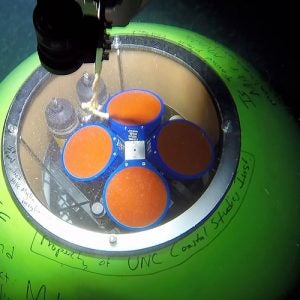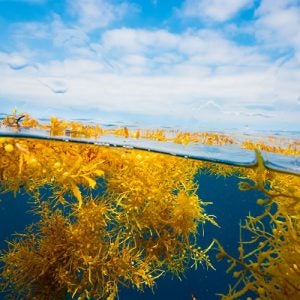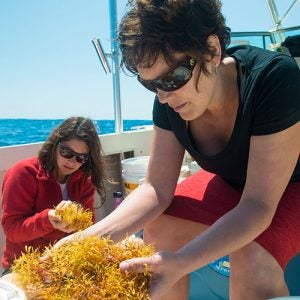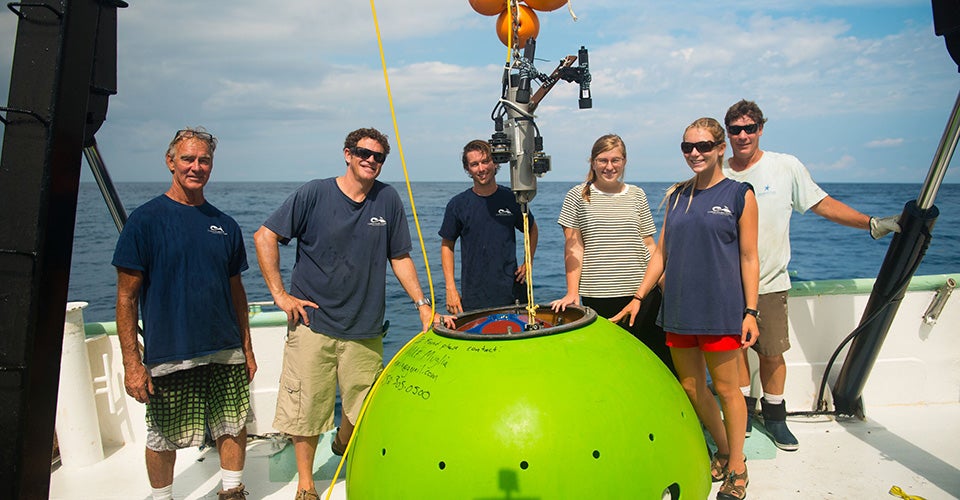ENERGIZED
Coastal Studies Institute rides cutting edge of energy research
A unique collaboration of academic experts and industry professionals in the field of renewable energy is gathering data and developing technologies that could play a key role in the future development of alternative energy sources.
Since 2010, the University of North Carolina Coastal Studies Institute (CSI) in Wanchese has led a renewable ocean energy research program funded by the state of North Carolina. Partnering with the colleges of engineering at N.C. State University (NCSU), UNC-Charlotte (UNCC) and N.C. A&T, the program has honed in on several key areas of renewable ocean energy research – efficient production, storage and transmission of energy, as well as permitting issues and environmental impact.
East Carolina University is the administrative campus for CSI, which was founded in 2003 and includes member institutions Elizabeth City State University, NCSU, UNC-Chapel Hill and UNC-Wilmington, as well as ECU.
Dr. Nancy White, CSI director, said the program’s first challenge was figuring out where to start, because little research had been done on offshore energy, other than some initial modeling projects related to offshore wind turbines.
“We sat down with the deans of these universities to decide the best way to move forward, and we convened a technical advisory committee … to set the priorities for what was important for North Carolina to do and how the state would fit into the global energy market,” she said.
Initially, the research focused on assessing the feasibility of producing energy from tidal flows, waves and the Gulf Stream. Eventually the latter was determined to be the most viable source of energy for North Carolina, as tidal flows and wave energy are not as powerful or consistent here as they are in other places in the world. Still, the N.C. coast can serve as a test bed for those technologies.
Gulf Stream
“The Gulf Stream is an enormous body of water that travels northward along our coast,” said John McCord, field operations coordinator for CSI. “Its flow generates about 45 times the power of all the rivers in the world combined.”
Mike Muglia, CSI researcher, helped put that into perspective. “Think about the Ganges, the Amazon, these giant rivers,” he said. “We measure current flow using a unit called the sverdrup. The Amazon River is about one-fourth of a sverdrup. The Gulf Stream is estimated at 60-90 sverdrups. So it’s a massive amount of flow.”
If that energy could be efficiently harnessed, stored and transmitted, it could be a substantial resource for not only N.C. but other states as well.

The UNC CSI’s “Doppler current profiler” tool is pictured on the ocean floor, where it tracks water flow for researchers.
“Just a few miles off the N.C. coast we have this huge power source,” White said. “That much power could run the Eastern Seaboard. It might be 20 years away, but you have to start somewhere.”
There are inherent challenges in efficiently harnessing energy from the current.
“The Gulf Stream has no boundaries, it wavers back and forth and it’s in really deep water,” said McCord. “So we’ve been researching where it would make sense for a device to be located.”
The Outer Banks are ideal because the Gulf Stream flows within 15-20 miles of Cape Hatteras before turning to the northeast toward Europe. Muglia and his team are working on modeling the Gulf Stream and determining the best possible site to generate energy, where the Gulf Stream is strong and consistent, yet close to shore and in shallow water to minimize the cost of capturing and transmitting the energy to shore.
There are three ways that the current can be tracked, Muglia said. The first is a land-based radar system that measures currents over a wide area, but only at the water’s surface. The second is a Doppler current profiler, a pod located on the ocean floor that measures the velocity of the current through the entire water column every 10 minutes. This device has been deployed for four years now, producing very detailed information about the current in that one location.
Finally, the same kind of Doppler current profiler is deployed from a boat, measuring the currents below the vessel as it moves across the Gulf Stream, providing detailed information for that moment in time. Each method has its advantages and limitations, Muglia said, but the team has gathered detailed and useful data over an extended period of time about the strength and location of the Gulf Stream.
Transmission and Storage
Another challenge the program is addressing is the conversion of low-speed rotation from energy conversion devices into the high-speed motion suitable for power generation. Typically, energy is converted through mechanical or hydraulic transmissions.
“The problem is that mechanical things don’t play well in the ocean,” said McCord. “They wear down and cause problems.”
Dr. Jonathan Bird, professor of electrical and computer engineering at UNCC, has been the lead researcher working to develop a magnetic transmission that has no touching gears.

Sargassum, a brown seaweed found in the Gulf Stream, is being simulated in UNC CSI labs to ensure energy research is not affecting offshore ecosystems.
“He’s working to develop and refine magnetic gear systems that use high-power neodymium magnets to produce a gearbox that has no touching parts,” McCord said. “It’s very efficient, with little friction loss.”
The technology could be useful for not only ocean energy but other forms of renewable and traditional energy as well. The U.S. Department of Energy has expressed interest, White said, and Bird is creating a startup company to continue the development.
Like wind and solar power, energy from the ocean can ebb and flow, while the power grid demands a steady and reliable source of energy, so storage is another critical challenge.
“Traditional batteries are expensive, heavy and dangerous, and electrical systems and salt water aren’t friends,” said McCord. “The idea with this project is to take advantage of the pressure gradient in the ocean.”
Pressure increases greatly with water depth. Using energy from ocean currents, wind turbines or other offshore sources to run a compressor, air is compressed and forced into a tank on the ocean floor, said Dr. Mohammed Gabr, professor of engineering at NCSU.
“Large quantities of air can be stored in a small amount of space at great depth,” he said. “The water pressure maintains the air compression.”
“Then when you need the power, you release some of that air through a piping system toward the surface, and it would power a turbine that runs on compressed air,” said McCord.
Gabr’s team has been working on models to address issues including temperature changes and water vapor as the air is condensed and compressed.
Environmental Impact
Finally, the researchers are keenly aware of the potential environmental impact of deploying devices to harness energy in the open ocean. Dr. Lindsay Dubbs, CSI research associate and a professor at UNC-CH, leads a team studying environmental assessment aspects of offshore energy production.
One thing the team is tracking is Sargassum, a brown seaweed that floats in clumps on the surface and is common in the Gulf Stream.

Dr. Lindsay Dubbs (foreground) and technician Molly Bost study Sargassum, a brown seaweed found in the Gulf Stream.
“When you have a current flowing past something that’s fixed, like a piling or something that’s anchored to the ocean floor, it creates turbulence,” McCord said. “We need to know what that does to the seaweed. So we’re simulating that in the lab to make sure that what we’re doing is not affecting offshore ecosystems.”
Graduate and undergraduate students play an active role in the research as well, gaining hands-on experience in a cutting-edge field. Eleven graduate students, mostly Ph.D. candidates, were partially or fully supported through the renewable ocean energy program during the 2015-2016 fiscal year.
“It has fostered a lot of Ph.D. and masters degree students, contributing to intellectual growth in an entirely new area,” White said.
Next week the researchers will update the technical advisory committee and other experts in the field on their progress as CSI hosts its annual Renewable Ocean Energy Symposium.
“We were very fortunate getting this project started, and I want to recognize the foresight of the N.C. General Assembly in recognizing the importance of the ocean as an energy resource,” said Billy Edge, who was the program’s first director and recently retired. “We have come a long way since that initial investment.”

CSI researchers and technicians prepare to deploy a Doppler current profiler to track water flow in the Gulf Stream.